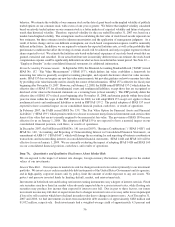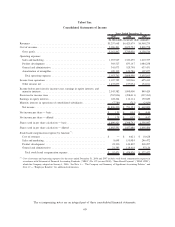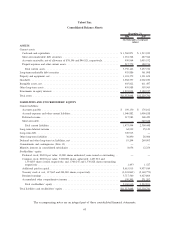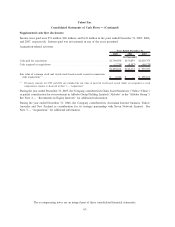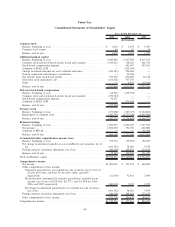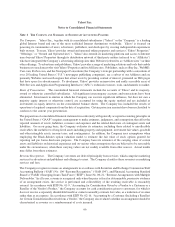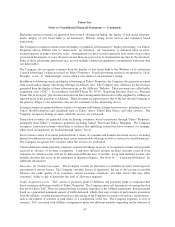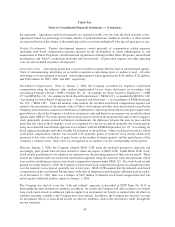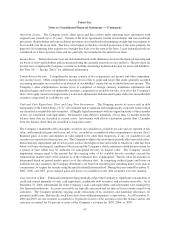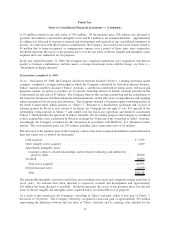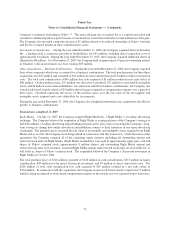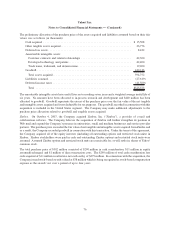Yahoo 2007 Annual Report Download - page 68
Download and view the complete annual report
Please find page 68 of the 2007 Yahoo annual report below. You can navigate through the pages in the report by either clicking on the pages listed below, or by using the keyword search tool below to find specific information within the annual report.Yahoo! Inc.
Notes to Consolidated Financial Statements
Note 1 THE COMPANY AND SUMMARY OF SIGNIFICANT ACCOUNTING POLICIES
The Company. Yahoo! Inc., together with its consolidated subsidiaries (“Yahoo!” or the “Company” is a leading
global Internet brand and one of the most trafficked Internet destinations worldwide. Yahoo! is focused on
powering its communities of users, advertisers, publishers, and developers by creating indispensable experiences
built on trust. To users, Yahoo! provides owned and operated online properties and services (“Yahoo! Properties,”
“Offerings,” or “Owned and Operated sites”). Yahoo! also extends its marketing platform and access to Internet
users beyond Yahoo! Properties through its distribution network of third-party entities (referred to as “Affiliates”)
who have integrated the Company’s advertising offerings into their Websites (referred to as “Affiliate sites”) or their
other offerings. To advertisers and publishers, Yahoo! provides a range of marketing solutions and tools that enable
businesses to reach users who visit Yahoo! Properties and its Affiliate sites. Publishers, such as eBay Inc., WebMD,
Cars.com, Forbes.com, and the Newspaper Consortium (the Company’s strategic partnership with a consortium of
over 20 leading United States (“U.S.”) newspaper publishing companies), are a subset of our Affiliates and are
primarily Websites and search engines that attract users by providing content of interest, presented on Web pages
that have space for advertisements. To developers, Yahoo! provides an innovative and easily accessible array of
Web Services and Application Programming Interfaces (“APIs”), technical resources, tools, and channels to market.
Basis of Presentation. The consolidated financial statements include the accounts of Yahoo! and its majority-
owned or otherwise controlled subsidiaries. All significant intercompany accounts and transactions have been
eliminated. Investments in entities in which the Company can exercise significant influence, but does not own a
majority equity interest or otherwise control, are accounted for using the equity method and are included as
investments in equity interests on the consolidated balance sheets. The Company has included the results of
operations of acquired companies from the date of acquisition. Certain prior year amounts have been reclassified to
conform to the current year presentation.
The preparation of consolidated financial statements in conformity with generally accepted accounting principles in
the United States (“GAAP”) requires management to make estimates, judgments, and assumptions that affect the
reported amounts of assets, liabilities, revenues and expenses and the related disclosure of contingent assets and
liabilities. On an on-going basis, the Company evaluates its estimates, including those related to uncollectible
receivables, the useful lives of long-lived assets including property and equipment, investment fair values, goodwill
and other intangible assets, income taxes, and contingencies. In addition, the Company uses assumptions when
employing the Black-Scholes option valuation model to estimate the fair value of stock options granted for
reporting and pro forma disclosure purposes. The Company bases its estimates of the carrying value of certain
assets and liabilities on historical experience and on various other assumptions that are believed to be reasonable
under the circumstances, when these carrying values are not readily available from other sources. Actual results
may differ from these estimates.
Revenue Recognition. The Company’s revenues are derived principally from services, which comprise marketing
services for advertisers and publishers and offerings to users. The Company classifies these revenues as marketing
services and fees.
The Company recognizes revenue on arrangements in accordance with Securities and Exchange Commission Staff
Accounting Bulletin (“SAB”) No. 104 “Revenue Recognition,” (“SAB 104”), and Financial Accounting Standard
Board’s (“FASB”) Emerging Issues Task Force (“EITF”) Issue No. 00-21, “Revenue Arrangements with Multiple
Deliverables.” In all cases, revenue is recognized only when the price is fixed or determinable, persuasive evidence
of an arrangement exists, the service is performed and collectability of the resulting receivable is reasonably
assured. In accordance with EITF No. 01-9, “Accounting for Consideration Given by a Vendor to a Customer or a
Reseller of the Vendor’s Product,” the Company accounts for cash consideration given to customers, for which it
does not receive a separately identifiable benefit or cannot reasonably estimate fair value, as a reduction of revenue
rather than as an expense. In accordance with EITF No. 02-16, “Accounting by a Customer (Including a Reseller)
for Certain Consideration Received from a Vendor,” the Company also evaluates whether an arrangement should be
characterized as revenue or a reimbursement of costs incurred.
66


